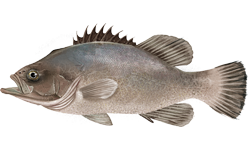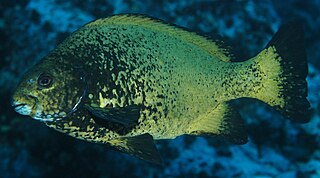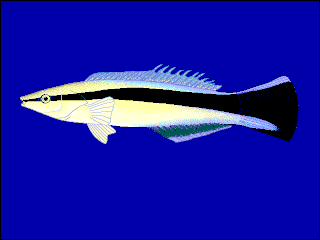
Acropomatidae is a family of ray-finned fish in the order Acropomatiformes, commonly known as lanternbellies. Acropoma species are notable for having light-emitting organs along their undersides. They are found in all temperate and tropical oceans, usually at depths of several hundred meters. There are about 32 species in as many as 9 genera, although some authorities recognise fewer genera than Fishbase does.

Holacanthus is a genus of marine angelfishes. The eight species are particularly abundant near volcanic rocks and coral islands. Some are highly valued as food, but even more so for aquaria, as all are brightly colored.

The wreckfish are a small group of ray-finned fish in the genus Polyprion, belonging to the monotypic family Polyprionidae in the order Acropomatiformes.

Trichogaster is a genus of gouramis native to South Asia from Pakistan to Myanmar. It is the only genus in the monotypic subfamily Trichogastrinae as set out in the 5th Edition of Fishes of the World, although that book states that there are two genera, the other being Colisa which is treated as a synonym of Trichogaster by Fishbase and the Catalog of Fishes. Fishbase also places the genus in the Luciocephalinae. Species of this genus are very popular in the aquarium trade.

The sea chubs, also known as rudderfish and pilot fish and in Hawaiian as enenue or nenue, are a family, Kyphosidae, of fishes in the order Perciformes native to the Atlantic, Indian and Pacific Oceans usually close to shore in marine waters.

Oplegnathus is currently the sole recognized genus in the knifejaw family (Oplegnathidae) of marine centrarchiform ray-finned fishes. The largest, the Cape knifejaw, can reach a maximum length around 90 cm (35 in). Knifejaws have teeth fused into a parrot-like beak in adulthood. They feed on barnacles and mollusks, and are fished commercially. They are native to the Indian and Pacific Oceans.

Characodon is a genus of splitfins endemic to north–central Mexico. Two of the species are highly threatened and restricted to pools, ponds and springs in the upper San Pedro Mezquital River basin in Durango. The third species, C. garmani, was restricted to springs near Parras in Coahuila, but it became extinct when they dried out.

Dermatolepis is a genus of marine ray-finned fish, groupers from the subfamily Epinephelinae, part of the family Serranidae, which also includes the anthias and sea basses. They are found in the western Atlantic, Pacific and Indian Oceans.

Plectropomus, commonly known as the coral groupers, is a genus of marine ray-finned fish, groupers from the subfamily Epinephelinae, part of the family Serranidae, which also includes the anthias and sea basses. They are found in the Indo-Pacific region.

The surge wrasse, also known as the green-blocked wrasse, purple wrasse or red and green wrasse, is a species of wrasse native to the southeast Atlantic Ocean through the Indian and Pacific Oceans, where it inhabits reefs and rocky coastlines in areas of heavy wave action at depths from the surface to 10 m (33 ft). This species is of minor importance to local commercial fisheries, is popular as a game fish, and can be found in the aquarium trade.

Labroides is a genus of wrasses native to the Indian and Pacific Oceans. This genus is collectively known as cleaner wrasses, and its species are cleaner fish.

Serpenticobitis, popularly known as serpent loaches, is a small genus of loaches found in the Mekong River Basin in Southeast Asia. It is the only genus in the family Serpenticobitidae.

Bangana is a genus of fish in the family Cyprinidae, the carps and minnows. It is distributed across much of southern and eastern Asia. Species live mainly in the flowing waters of tropical and subtropical rivers.

Pseudocaranx is a genus of ray-finned fishes from the family Carangidae, the jacks, trevallies, scads, and pompanos. They occur in the western Atlantic Ocean and the Indo-Pacific.

Scorpis is a genus of marine ray-finned fish from the family Scorpididae which are native to the eastern Indian Ocean and the Pacific Ocean.

Gomphosus is a small genus of wrasses native to the Indian and Pacific Oceans.
Gymnostomus is a genus of cyprinid fish found in Southeast Asia.

Pelates, is a genus of ray-finned fish in the family Terapontidae, containing 3 species.

The threadtail anthias is a species of marine ray-finned fish in the family Anthiadidae. It is the only member of the genus Tosana. It is found in the Western Pacific Ocean from Japan to the South China Sea in deep coastal waters over sandy-muddy substrates.

The ara, otherwise known as the saw-edged perch or the Dageumbari (다금바리) is a species of marine ray-finned fish from the monospecific genus Niphon in the monogeneric family Niphonidae. It is found in the Western Pacific Ocean from Japan south to the Philippines where it inhabits rock reefs and inshore waters with rocky sea beds. This species can grow up to 1 metre (3.3 ft) in total length. The ara was first formally described in 1828 by Georges Cuvier in the Histoire naturelle des poissons which he co-authored with Achille Valenciennes, the type locality was given as the Sea of Japan.











































